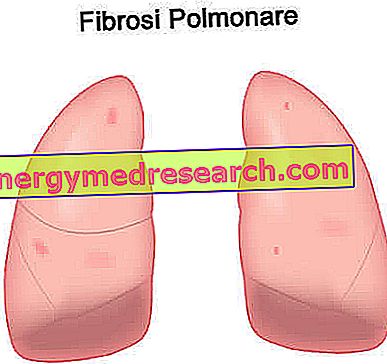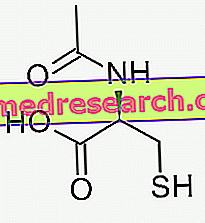Generality
The bagged finger is a fairly common injury, especially in sports.

This traumatic event consists of a slight distortion, caused by a very violent impact of the end of the finger itself. This results in swelling and pain when trying to extend or flex the involved phalangeal joint. The limitation that follows is often a function of the degree of joint swelling.
The bagged finger tends to heal on its own, without the need for special treatments, even if there are some precautions that can alleviate the symptoms and speed up the healing time. Usually, these include the immobilization of the injured part by bandaging or guardians and the application of ice packs for a few days. Only in certain circumstances, the bagged finger needs medical or surgical treatment (such as aspiration of synovial fluid or endoscopic repair of a damaged joint component), to restore finger function to normal and fully recover movement.
What's this
The bagged finger is one of the most common traumatic injuries that occur at the level of the fingers .
More precisely, it is a distortion due to the violent impact of the extremities of the hands or feet (phalangeal joints). This condition can be a consequence, for example, of the impact of the ball on the tip of the finger itself, playing basketball or volleyball .
What is a distortion?
- The bagged finger is a slight distortion (normally 1st or 2nd degree).
- This injury to the musculoskeletal system is caused by indirect trauma . The distortion is determined when a force forces the affected part to perform a sudden and abrupt movement, beyond the physiological limits, with a lever or torsion mechanism .
- The displacement of the joint towards an "unnatural" direction therefore causes a temporary and partial loss of contact between the articular heads, with or without laceration of the ligaments (note: if the loss of the relations between the capsuloligamentous structures is permanent, we talk about dislocation ).
Causes and Risk Factors
The bagged finger is caused by a traumatic event that affects the extremity of the hands and feet .
This type of injury is caused by forced flexion of the phalangeal joints : during a game of basketball or volleyball, for example, it may happen that the athlete's open hand impacts with the ball in an attempt to grab it, deflect it or make a wall.

The bagged finger is one of the "minor" injuries that may occur during sports activities; in fact, the hyperflexion of the extensor tendon near its insertion on the distal phalanx can be related to important traumas, such as a tendon rupture or a bone fracture, with the involvement - more or less severe - of various articular components (ligaments, joint capsule, cartilage, joint surfaces, etc.).
Bagged finger: those most at risk
The bagged finger is very common among sportsmen, especially among those who play volleyball, rugby, basketball and water polo.
Within the hand, the distal interphalangeal articulation of the 5th finger (ie the little finger) is the most affected area, followed by that of the central fingers and the metacarpophalangeal joint of the thumb.
Symptoms and Complications
The main symptoms of bagged finger are:
- Pain in the affected joint, which is accentuated with the movement - that is to the extension and flexion of the extremity of the hand or of the foot involved by the trauma - and with a pressure in correspondence of the ligaments or of their insertions on the bone;
- Swelling that gradually increases after the trauma;
- Motor inability or difficulty in fully extending the finger, resulting in a functional deficit.
After a trauma to the hand or foot, the signs of the bagged finger appear within a short time. The pain is alive and immediate, but decreases after 2-3 minutes after the distortion, generally allowing the resumption of activity. Joint restriction is most often caused by swelling, almost always present in the case of a bagged finger. In the hand, it is not possible to close the fist. Subsequently, hematomas and effusion may also occur at the level of the joint involved.
In the most severe cases, a partial laceration of the ligaments or a detachment of these from their insertion sites can occur, with joint instability .
Possible complications
Trauma to the hand or foot can cause injuries of varying degrees. The bagged finger is, in fact, one of the most common consequences of this occurrence, but can also occur, with similar modalities:
- Stretch or tendon rupture due to forced flexion of the distal interphalangeal joint;
- Rupture of the part of the bone where this tendon is inserted (condition called " avulsion fracture ").
If the trauma appears complex and, above all, when it is associated with lesions of other tissues (such as nerves or tendons), it is advisable to consult a doctor for the necessary checks. Delaying the treatment of any problems associated with the bagged finger can cause permanent functional damage or make healing more difficult.
Therefore, if the trauma is particularly violent, it is advisable to immobilize the affected area and contact your doctor as soon as possible so that the extent of the lesion is assessed: first the bagged finger and the related consequences are treated, the better the recovery.
Bagged finger: when to seek medical attention
After the responsible injury of the bagged finger, it is advisable to consult your doctor or contact the emergency room should the following situations occur:
- The nail appears damaged and / or about to detach itself;
- At the bagged finger, the pain is very strong;
- A blood loss occurs that does not stop after 10 minutes of compression of the affected part;
- The bagged finger is very swollen;
- The patient is unable to stretch or bend even a finger joint;
- The skin of the bagged finger has a laceration and / or in the wound there is earth or other foreign material that cannot be removed.
These manifestations can indicate the presence of conditions that can be complicated in more serious pathologies, such as, for example, the permanent loss of the nail or the possibility of incurring infections. Furthermore, it may happen that a neglected bagged finger corrodes important joint stiffness or early arthrosic degeneration.
Diagnosis
The diagnosis of the bagged finger is based on clinical evaluation, but the practice involves performing a radiological check to exclude the presence of a bone fragment, which could have come off near the insertion of the tendon, following a very violent trauma.
In fact, as anticipated, traumas at the level of the finger joints can cause more or less serious injuries, such as, for example, dislocations or fractures. The latter two eventualities must be treated with adequate immobilization and, sometimes, with surgical therapy. For this reason a medical check-up is always recommended, even if the trauma was mild or moderate.
The characteristics of the bagged finger allow to define the most appropriate therapeutic approach to be adopted.
Bagged finger: what tests are needed for the diagnosis?
- Physical examination . The end of the hand or foot is inspected during the physical examination. The diagnosis of bagged finger is confirmed by the evident presence of the clinical signs described above.
- Radiography. A radiographic examination allows to establish that the cause of the bagged finger is a distortion, excluding, at the same time, other lesions (stretching or rupture of the tendon) and the presence of an eventual bone fragment at the base of the distal phalanx (avulsion fracture).
- Ultrasound and associated investigations . Depending on the case, the patient presenting a bagged finger may be subjected to an ultrasound scan to observe the state of the tendons; this examination can be associated with doppler or electromyography to verify the functioning of blood vessels or nerves.
Treatment
The management of the bagged finger varies according to the extent of the distortion and the symptomatology that follows. The strategies to alleviate this traumatic injury involve first-aid measures and treatments in the weeks following the injury.
Cold packs and rest
Immediately after the accident, to reduce swelling, it is useful to apply cold compresses on the bagged finger, by immersing the aching part in water and ice or by wrapping some cubes in a towel or cloth to protect the skin. The doctor can also advise resting the joint for 2-3 days and, if the trauma is recent, immobilization, with an elastic compressive bandage, in order to minimize the swelling of the bagged finger.
Tutor and functional bandage
For competitive reasons, the injured finger can be tied together with the adjacent one, to adequately protect it from accidental contact. This allows for relief from symptoms and sometimes makes it possible for the athlete to return to the field immediately.
If the pain and swelling persist, the doctor may indicate the use of a brace (or splint), that is a special rigid plastic (or aluminum) splint, which keeps the finger in an upright position and with the extremity slightly turned backwards (ie with the last extended phalanx).

The immobilization of the bagged finger allows the terminal interphalangeal joint to be maintained in extension and, during healing, allows the structures involved in the trauma to rest.
Conservative treatment can be adopted for different periods of time:
- If the bagged finger is affected by a simple distortion (ie the tendon is not torn or otherwise damaged) it should heal in about 4 to 6 weeks, wearing a brace all the time. If the instability of the bagged finger is of a high degree, the immobilization will last longer and, subsequently, it is possible to begin rehabilitation.
- If the tendon is torn or there is a small bone detachment: the brace should be worn day and night for 6 - 8 weeks to allow the two ends of the torn tendon or bone fracture to heal. After this period, it is necessary to wear this support for another 3 - 4 weeks, only during the overnight stay. If you expected to start treatment, you may need to wear the brace longer.
Correct use of brace in case of bagged finger
Indications for use of brace for bagged finger and instructions for placement should be provided by your doctor or a qualified professional. In fact, to ensure the fastest healing, it is important to make sure that the support fits properly to the part of the hand or foot involved in the trauma. In practice, the brace must be tight enough to keep the finger in the right position, but not so tight as to interrupt the flow of blood (note: if the skin is white when the device is removed, it could mean that the device forces the area). For the time indicated by the doctor, the brace should be removed from the patient only for daily cleaning.
When sports activity is resumed, for 7-10 days, it is possible to use a functional bandage (taping) to avoid harmful overloads in the ligaments damaged by the trauma and prevent further relapses.
Drugs and other symptomatic remedies
- Although it is still possible to use the bagged finger, it is important to remember not to move it too much, as it could delay healing and cause permanent damage.
- For pain relief, pain medications such as paracetamol, ibuprofen or naproxen can be taken, again on medical advice.
- Even resorting to an ice pack for 10-20 minutes, 3 times a day or as needed, can help reduce swelling.
Rehabilitation exercises
At the end of the immobilization phase (and therefore to the removal of the brace), exercises of joint mobilization and reinforcement of the intrinsic muscles of the hand or foot begin as soon as possible. This rehabilitative treatment makes it possible to recover the full efficiency and strength of the bagged fingers, with the aim of resuming the movement of the damaged joints and avoiding the appearance of joint limitations or stiffness.
In this recovery phase it is important not to overdo the movements, to avoid damaging the joints, ligaments or joint capsule again.
Bagged finger: What to do (in short)
- To relieve pain and reduce swelling, it is recommended to dip the bagged finger in water and ice for 10-20 minutes.
- Take an analgesic drug, such as paracetamol, to relieve pain.
- For a few days, tie the affected finger to the next one with a plaster in order to protect it from accidental contact.
- Contact your doctor if the pain does not improve within 2-3 days or if the normal function of the bagged finger does not return within a week.
- If the bagged finger is a recurring problem, protect with a band-aid or a functional bandage (taping), the sensitive fingers before training or playing, for at least 3-4 weeks.
Signals to watch out for
The patient should consult the doctor if:
- The bagged finger is still swollen at the end of the treatment;
- Pain tends to get worse;
- Numbness or tingling develops at the end of the finger and the skin changes color.
In the most serious cases of bagged finger, interventions such as aspiration of synovial fluid or surgery with minimally invasive endoscopic techniques may be necessary.



